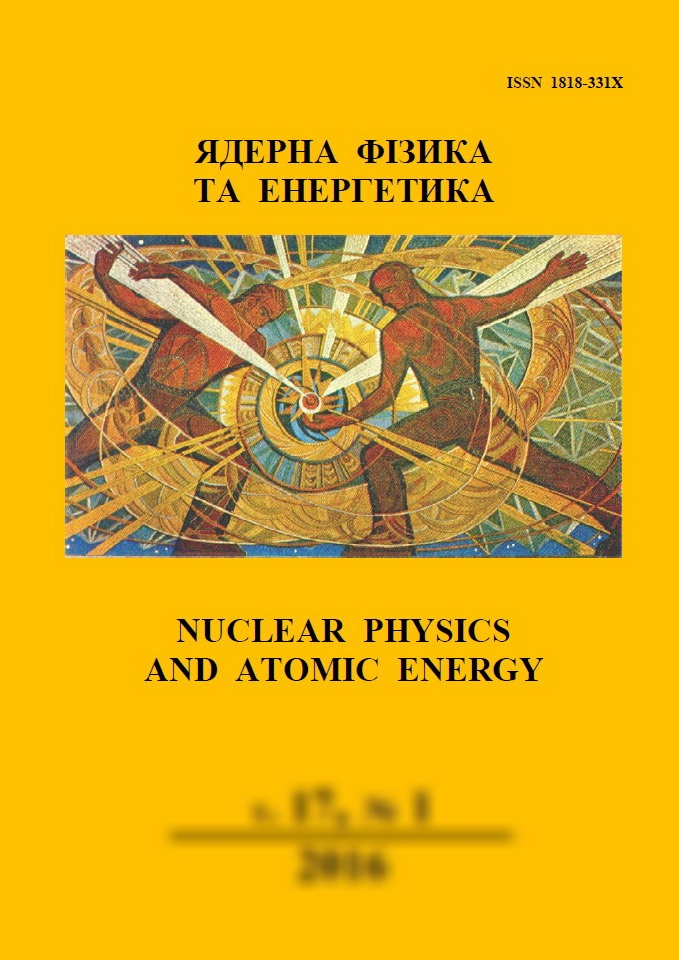 |
ядерна ф≥зика та енергетика
Nuclear Physics and Atomic Energy
ISSN:
1818-331X (Print), 2074-0565 (Online)
Publisher:
Institute for Nuclear Research of the National Academy of Sciences of Ukraine
Languages:
Ukrainian, English
Periodicity:
4 times per year
Open access peer reviewed journal
|
Nucl. Phys. At. Energy 2001, volume 2, issue 1, pages 19-30.
Section: Nuclear Physics.
Published online: 30.03.2001.
 Full text (en)
Full text (en)
https://doi.org/10.15407/jnpae2001.01.019
Viscosity effects at the nuclear descent from the fission barrier
S. V. Radionov, F. A. Ivanyuk, V. M. Kolomietz, A. G. Magner
Institute for Nuclear Research of the National Academy of Sciences of Ukraine
Abstract:
We evaluate the temperature Tscis at the scission point and the descent time τsc from the saddle to
the scission of heated nuclei within the liquid-drop model. We use the classical Lagrange-like equations of
motion. The nuclear surface is parametrized by the two-parametric family of the Lawrence shapes.
Conservative forces are defined through the free energy of the nucleus. We use the friction tensor derived
from the boundary conditions on the nuclear surface and from exact solution of the continuity equation for
incompressible and irrotational flow. The scission line is determined from the instability condition of the
nuclear shape with respect to the variations of the neck radius. The numerical solution of the dynamical
equations is carried out for the nucleus 236U. We have defined the viscosity coefficient μ from the
comparison of the experimental data for the kinetic energy of the fission fragments with computed one. We
found a significant deviation of μ obtained within our approach from the value of μ obtained within the
standard hydrodynamical model.
References:
1. Davies K. T. R., Sierk A. J., Nix J. R. Phys. Rev. C 13 (1976) 2385.
https://doi.org/10.1103/PhysRevC.13.2385
2. Ivanyuk F. A., Kolomietz V. M., Magner A. G. Phys. Rev. C 52 (1995) 678.
https://doi.org/10.1103/PhysRevC.52.678
3. Landau L. D. and Lifshitz E. M. Fluid Mechanics (Addison-Wesley: Reading, Mass., 1959).
4. Myers W. D., Swiatecki W. J. Ark. Fys. 36 (1967) 343.
5. Jeffreys H., Swirles B. Methods of Mathematical Physics (Cambridge: Cambridge University Press, 1966).
6. Hasse R. W., Myers W. D. Geometrical Relationships of Macroscopic Nuclear Physics (Berlin: Springer-Verlag, 1988).
https://doi.org/10.1007/978-3-642-83017-4
7. Chubarian G. G. et al. Progress in Research (Apr. 1, 1995 Mar. 31, 1996 (Texas: A&M University, Cyclotron Institute, 1996) p. 58.
8. Berdichevsky V. L. Variational Principle for Mechanics of Continua (Moskow: Nauka, 1983).
9. Landau L. D., Lifshitz E. M. Statistical Physics (New York: Pergamon, 1958).
10. Guet C., Strumberger E., Brack M. Phys. Lett. B 205 (1988) 427.
https://doi.org/10.1016/0370-2693(88)90971-9
11. Ravenhall D. G., Pethick C. J., Lattimer J. M. Nucl. Phys. A 407 (1983) 571.
https://doi.org/10.1016/0375-9474(83)90667-X
